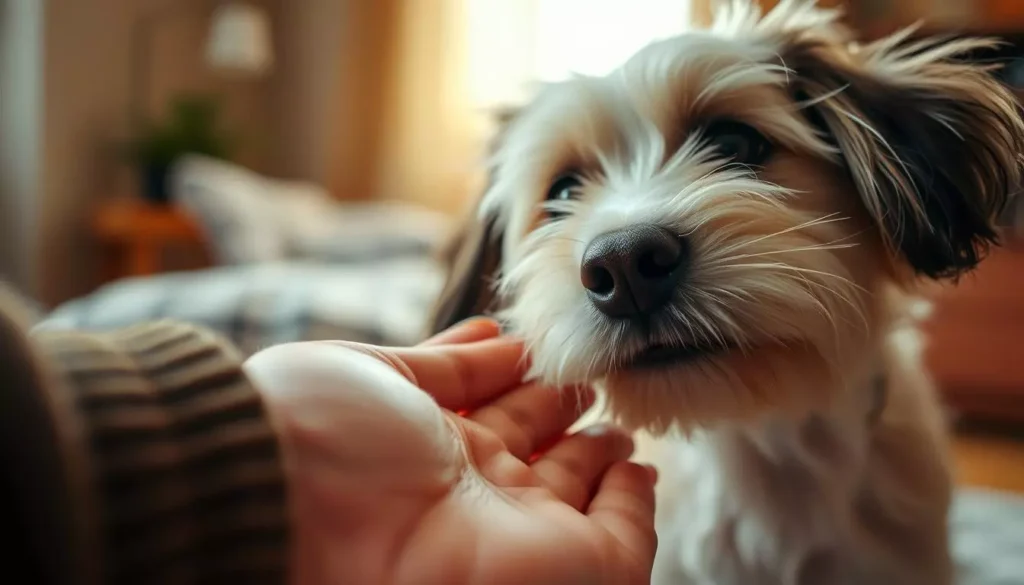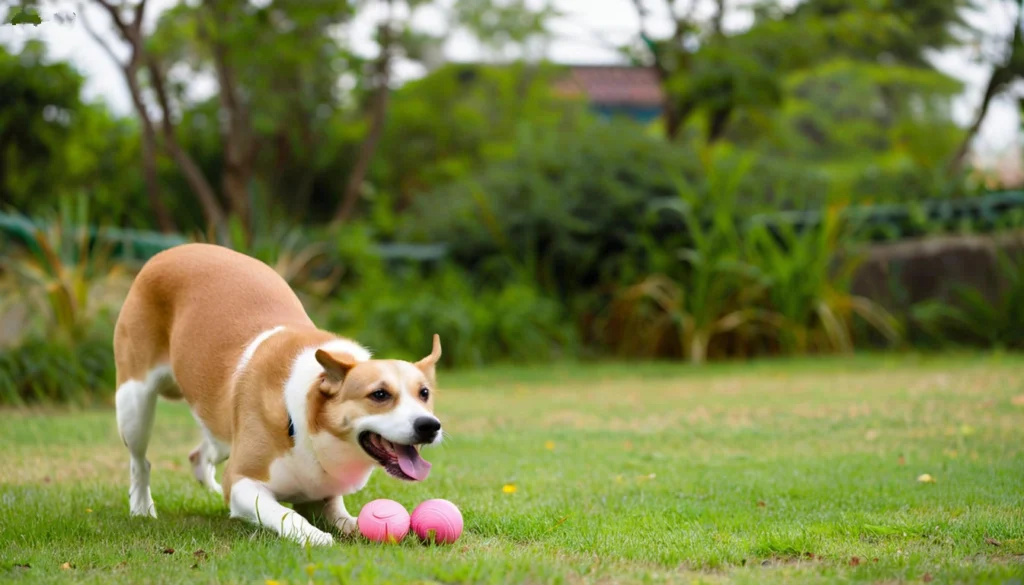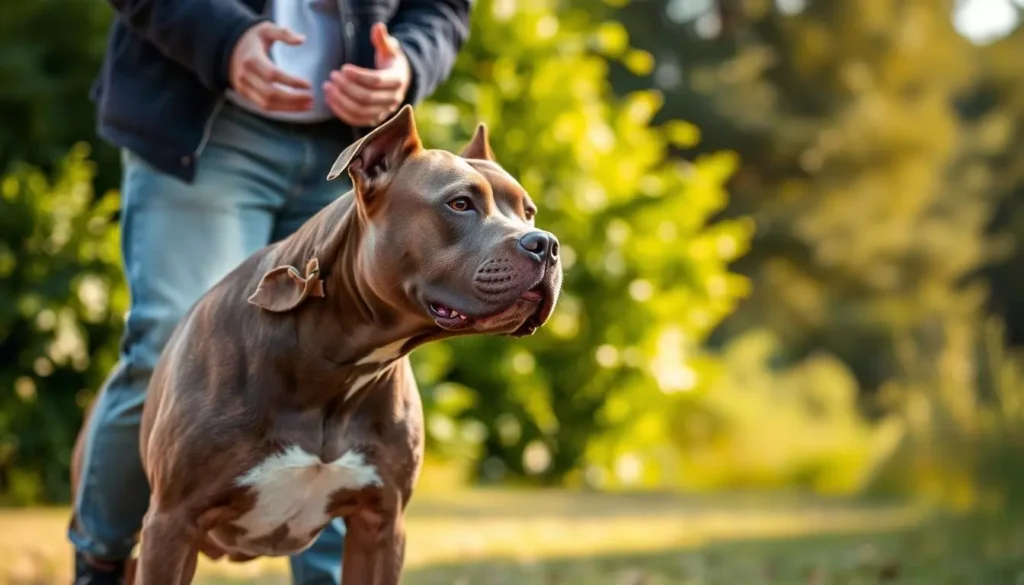Every dog owner knows that special moment when you pick up your furry friend. It's filled with love and trust. But it also comes with a big responsibility. Picking up a dog is not just about lifting; it's about keeping them safe and comfortable.
I remember the first time I held my puppy. I felt joy and anxiety at the same time. Would I hold her right? Would she feel safe? That moment taught me the importance of learning the best way to lift a dog.
It's not just about avoiding injury. It's about building a strong bond with your pet. In this article, we'll look at safe and practical ways to pick up dogs of all sizes. This way, you and your pet can enjoy those special moments without worry or discomfort.
Key Takeaways
- Understanding how to safely pick up a dog is essential.
- Different techniques are required for small and large breeds.
- Proper lifting techniques can prevent injuries for both the dog and the owner.
- Being aware of your dog’s comfort level is crucial.
- Using positive reinforcement during lifting can encourage your dog.
Understanding When You Need to Pick Up Your Dog
Knowing when to pick up your dog is important for its happiness. Sometimes, you might need to lift your dog to keep it safe. This could be when you're walking on rough terrain or during loud events like thunderstorms.
Also, if your dog looks tired or hurt, it's time to pick it up. Before lifting, check if your dog is calm or not. If it seems stressed or uncomfortable, it's best to wait.
It's also crucial to understand your dog's body language. A wagging tail means it's happy, but a tucked tail might show fear. Knowing these signs helps us have better times together.
The Best Way to Pick Up a Dog
Picking up a dog the right way means being calm, confident, and using the right technique. I slowly approach my dog, letting them know I'm about to lift them. This makes them feel more at ease and less anxious.
When lifting small dogs, I use my dominant arm to support their chest and the other to cradle their backside. This keeps them secure and comfortable. For larger dogs, I bend my knees and lift with my legs. This way, I avoid straining my back and ensure the dog's safety.
By following these steps, I not only lift my dog safely but also strengthen our bond. It makes lifting them a positive experience for both of us.
Techniques for Picking Up Small Dogs
When lifting a small dog, their comfort and safety are key. It's all about using the right way to hold them. This ensures they feel safe and cared for. Here are steps to lift small breeds safely and avoid common mistakes.
Step-by-Step Guide to Lifting Small Breeds
- Start by squatting close to your dog. This makes them feel more secure.
- Place one hand under their chest, near the front legs.
- Use your other hand to support their rear, cradling them along your body.
- Gently lift while keeping them close to avoid any anxiety or discomfort.
- Always ensure you're using a smooth motion to prevent startling them.
Common Mistakes to Avoid with Small Dogs
- Lifting by the scruff of their necks can cause pain and distress.
- Grabbing under their arms may strain their joints and make them uncomfortable.
- Forgetting to support their back can lead to injury.
- Not paying attention to their body language can signal discomfort.
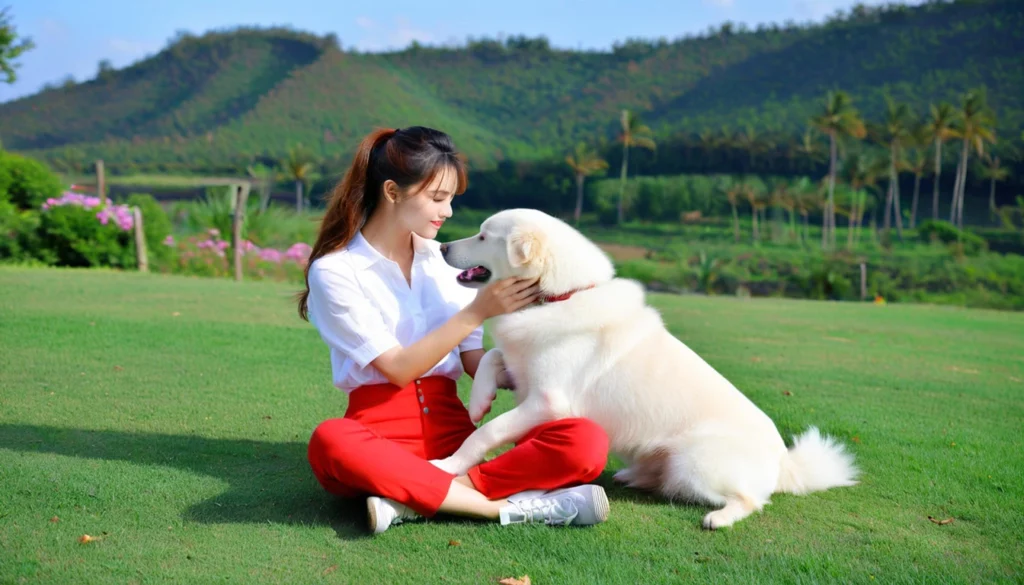
Techniques for Picking Up Large Dogs
When picking up a large dog, using the right technique is crucial. It keeps both me and the dog safe. The key is to lift properly to avoid injuries.
Proper Support for Bigger Breeds
Wrapping one arm around the dog's chest and the other under their rump is best. This way, I can lift them evenly. It's also important to lift with my legs to protect my back.
When to Seek Help for Heavy Dogs
If the dog is over 40 pounds, getting help is a good idea. A second person can make lifting easier and safer. This approach keeps the dog comfortable and prevents injury to me.
How to Safely Pick Up a Dog Without Hurting It
Picking up a dog needs care and knowing what they like. A firm but gentle way makes them feel safe. This way, I can lift them without making them uncomfortable or scared.
Importance of a Secure Grip
Having a strong grip is key when lifting a dog. It lets me lift them safely and without sudden moves that scare them. Holding them gently in both arms and supporting their back keeps them balanced.
This makes them feel secure and strengthens our bond. It shows them I care about their comfort and safety.
Understanding Your Dog's Comfort Level
Knowing when your dog is comfortable is important. If they stiffen or bark, they might not want to be lifted. I watch for these signs to adjust how I lift them.
Keeping things calm helps me see if they're ready. This way, lifting them becomes a positive experience for both of us. It makes our relationship better.
Using Positive Reinforcement
Using positive reinforcement for dogs can change the game when picking them up. It makes the experience better for both of us and builds trust. By using specific cues and treats, my dog feels more at ease and less anxious.
How Cues and Treats Can Help
Verbal cues have been key in my approach. By linking a command, like "up," to being lifted, my dog knows what's coming. Treats motivate my dog to respond correctly, making them more cooperative and calm.
To show how well positive reinforcement works, I've made a table. It lists cues and their rewards:
| Cue | Action | Reward |
|---|---|---|
| "Up" | Lifting the dog | Treat |
| "Come" | Dog approaches | Praise and petting |
| "Settle" | Calm behavior during lifting | Treat |
Consistently using these cues strengthens our bond and improves my dog’s behavior. This method makes picking them up smoother and less stressful for both of us.
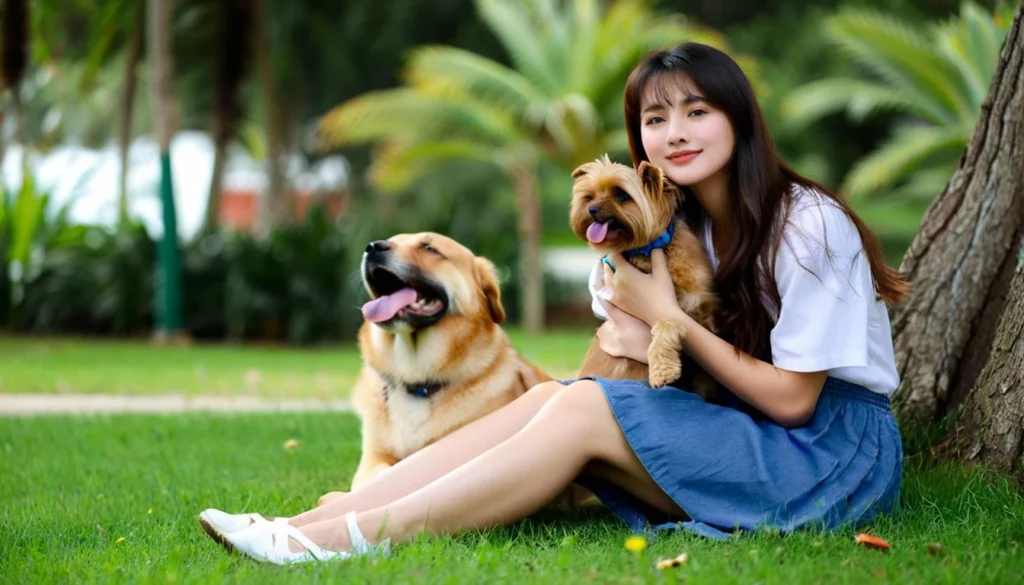
Signs Your Dog is Uncomfortable Being Picked Up
It's important to know when our dogs are stressed. This helps us communicate better with them. When I pick up my dog, I want them to feel safe and comfortable.
If my dog gets tense, growls, or tries to get away, it's a sign they're not okay with being picked up.
Seeing these signs helps me change how I pick them up. This makes the experience better for my dog. Some key signs include:
- Tense body posture - My dog may stiffen or hold their body rigidly.
- Growling or barking - Vocalizations can signal discomfort or stress.
- Attempting to flee - If my dog tries to move away, it suggests they do not want to be lifted.
- Flattened ears - This can reflect fear or anxiety about being picked up.
- Tail tucked between legs - This behavior often signals a state of fear or submission.
By paying attention to these signs, I can adjust how I lift my dog. Or, I might find other ways to keep them safe and calm.
Carrying a Dog Safely: What to Know
After picking up my dog, I make sure they're safe while I carry them. This means paying close attention and knowing how to keep them secure. Holding them tight but gently is key to their comfort and calmness.
Best Practices for Keeping Your Dog Secure
Carrying a dog safely means giving them the right support. This is especially important for their legs and backside. It helps them feel more secure and less stressed during the trip. Here are some important tips to keep my dog safe and happy:
- Keep the dog close to my body for a sense of security.
- Avoid swift arm movements that might startle them.
- Provide steady support with both arms to ensure stability.
- Maintain a calm demeanor to help soothe any nervousness.
- Be mindful of my dog's position, adjusting as needed for comfort.
Following these best practices not only keeps my dog safe but also makes the journey fun for both of us.
Preventing Dog Bites When Picked Up
It's key to prevent dog bites, especially when picking up my dog. Knowing their body language and keeping calm helps. I should move slowly to make them feel safe.
This makes them less likely to react badly. Keeping calm myself helps my dog stay calm too. It's vital when dealing with nervous dogs.
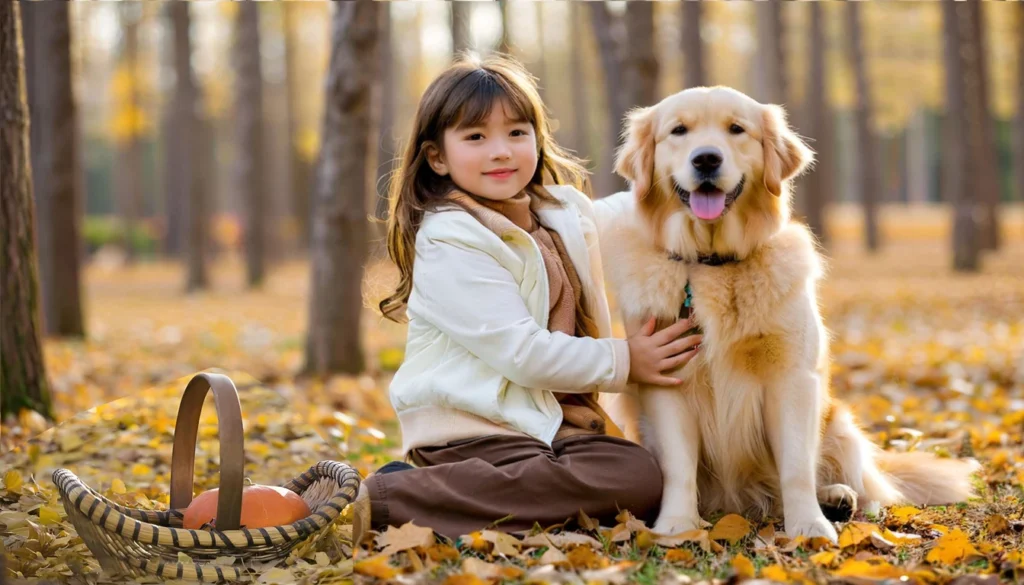
What to Do if Your Dog Bites You
If bitten, staying calm is the first step. Clean the bite with soap and water. Watch for signs of infection.
If the bite is bad or bleeds a lot, get medical help. Thinking about what caused the bite helps prevent future incidents.
Tips for Handling Nervous Dogs
Dealing with nervous dogs needs patience and understanding. Here are some tips:
- Use gentle movements to avoid startling them.
- Give treats to make being picked up positive.
- Wrap them in a light towel for comfort.
These tips help avoid dog bites when picking them up. A routine helps my nervous dog get used to being lifted. With time, handling them becomes less stressful for both of us.
Proper Technique for Picking Up a Dog
Knowing how to lift a dog properly is key. The right way to do it keeps your pet safe and comfortable. It also helps prevent injuries to you. I've learned a few important steps that make lifting my dog easier and more fun.
Key Techniques to Remember
When lifting dogs, especially big ones, it's important to support their chest and back. For smaller dogs, holding them close and safely is best. Here are some key techniques I always remember:
- Always bend at my knees instead of my back when lifting.
- Ensure a gentle grip, holding the dog securely without causing discomfort.
- Lift smoothly and steadily to avoid startling my pet.
- Communicate with soothing words to keep my dog calm during the lift.
By following these techniques, I can lift my dog confidently. This ensures we both stay safe and comfortable.
Common Dog Behaviors When Being Lifted
When I lift my dog, I see different behaviors that show how they feel. Knowing these signs helps us connect better and makes lifting more enjoyable for both of us. Growling and barking can tell us a lot about their mood and comfort when handled.
Understanding Growling and Barking
Growling and barking aren't always about being aggressive. They are ways dogs communicate. It's important to understand what they mean. Here are some reasons dogs might growl or bark when lifted:
- Discomfort: Growling might mean my dog feels uneasy or scared.
- Alertness: Barking could mean they've noticed something odd.
- Playfulness: Barking can also mean they're excited to play.
- Boundary setting: Growling might show they need more space.
It's key to recognize these behaviors when lifting my dog. By paying attention to their body language and sounds, I can make lifting a better experience for them.
Special Considerations for Puppies
When picking up puppies, I make sure they feel safe and comfy. The early experiences of young dogs shape their future behavior. I focus on building trust and positive experiences to help them grow well-adjusted.
Encouraging Positive Experiences for Young Dogs
To create a positive environment, I handle puppies gently. Here are some strategies I use:
- Speak softly and calmly to the puppy as I lift them.
- Make lifting a routine part of playtime to create familiarity.
- Use treats immediately after picking them up to reinforce a positive reaction.
- Keep the lifting time short at first, gradually increasing it as they become more comfortable.
These actions help puppies feel safe, leading to positive experiences. By considering their needs, I help them build confidence and trust in their owners.
How to Lift an Injured or Older Dog
Lifting an injured dog or an older dog needs careful thought and technique. It's vital to keep my pet safe during this time. Using a proper lifting harness for dogs makes lifting safer and more comfortable for them.
These harnesses support the dog's body and spread out the weight. This is key when dealing with injuries or mobility issues.
Using a Lifting Harness Effectively
Choosing the right harness is the first step. A good fit prevents injuries and keeps my dog safe. I look for harnesses with adjustable straps and padding for comfort.
Before lifting, I make sure the harness is snug but not too tight. This lets my dog breathe easily.
Positioning myself correctly is also important. I bend my knees and keep my back straight. This way, I lift with my legs, not my back. It helps me stay balanced and keeps my dog secure.
If my pet seems anxious, speaking softly can calm them down. This makes the lifting process easier for both of us.
The right way to lift an injured or older dog can reduce their discomfort. If my dog has trouble, I might talk to a vet for advice. Taking these steps ensures a safe and gentle lift for my pet and me.
Why Does My Dog Bark When I Hug Someone?
When I hug someone, my dog might bark. This can make me wonder why they react this way. It's possible they feel confused or uncomfortable when I hug someone.
My dog might bark because they want attention or don't understand what's happening. Each bark can mean something different, like annoyance, excitement, or a need to protect.
I try to understand my dog's feelings by watching their body language and tone. If they bark while I hug someone, it might mean they're feeling left out or anxious. By paying attention to their behavior, I can better understand their emotions.
Picking Up Dogs with Special Needs
Lifting dogs with special needs needs a careful plan. I think about their unique challenges, like mobility issues or anxiety. Knowing what special needs dogs need helps keep them safe and comfortable.
Before lifting my dog, I check their physical and emotional state. I use supportive gear like harnesses or slings. These tools help support them and lower the risk of injury, making the experience better for both of us.
Using Products Designed for Carrying Dogs
Having the right gear is key when lifting and moving my dog. There are many carrying gear for dogs options out there. They meet different needs, sizes, and preferences. Using the right products ensures my dog's safety and comfort while we're on the move.
Overview of Carrying Gear Available
The market has a wide range of dog carrying products. You can find slings, backpacks, and harnesses. Here are some top picks:
- Dog Slings: Perfect for small dogs, they offer a cozy spot to rest while keeping my hands free.
- Backpacks: Great for outdoor trips, they let me carry my dog and other gear at the same time.
- Carrying Harnesses: These harnesses provide extra support and comfort, especially for older or injured dogs.
Choosing the right carrying gear for dogs is easier when I consider my dog's size and weight. Looking at online reviews and product specs helps me find the best fit for my dog.
How Not to Pick Up a Dog
Lifting my dog the right way is crucial for its safety and comfort. There are certain things I should avoid to prevent any harm. Knowing what not to do ensures a good experience for my dog.
Techniques and Practices to Avoid
Using the wrong lifting techniques can harm my pet. Here are some common mistakes to avoid:
- Lifting by the scruff: This can hurt my dog and is not safe.
- Grabbing under the armpits: This can stress the dog's joints and is uncomfortable.
- Stretching the dog’s body: Overstretching can cause injury.
- Forcing the lift: If my dog resists, I should not force it, as this can cause anxiety or fear.
- Ignoring the dog’s signals: Not recognizing my dog's discomfort or fear can lead to stress and potential bites.
Avoiding these mistakes helps create a safer and more comforting lifting experience for my dog. It's important to know what not to do to ensure my dog's safety and happiness.
| Mistake | Why to Avoid It |
|---|---|
| Lifting by the scruff | This can cause pain and feel threatening to the dog. |
| Grabbing under the armpits | This can place undue stress on joints and muscles. |
| Stretching the dog’s body | Can lead to strains or sprains. |
| Forcing the lift | May instigate fear or aggression in my dog. |
| Ignoring the dog’s signals | This can escalate anxiety or discomfort, leading to negative behavior. |
Conclusion
Picking up a dog right is all about technique, empathy, and knowing what they need. I've looked into the best ways to do it, making sure I watch for their comfort signs. This way, lifting them becomes a nice thing to do.
Looking back, a few easy steps can really help. Whether it's a small or older dog, the right way to lift them is key. It keeps us both safe and happy, and it makes our bond stronger.
Using what I've learned, I want to make our time together better. Following these best practices keeps my dog safe and makes our moments together more enjoyable. It's a win-win for both of us.


